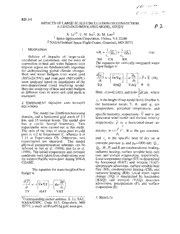
NASA Technical Reports Server (NTRS) 19990014072: Impacts of Large-Scale Circulation on Convection: A 2-D Cloud Resolving Model Study PDF
Preview NASA Technical Reports Server (NTRS) 19990014072: Impacts of Large-Scale Circulation on Convection: A 2-D Cloud Resolving Model Study
8D.11 IMPACTS OF LARGE-SCALE CIRCLUATION ON CONVECTION: A 2-D CLOUD RESOLVING MODEL STUDY X. L1I* , C.-H. Sui 2, K.-M. Lau 2 1Space Application Corporation, Vienna, VA 22180 2 NASA/Goddard Space Flight Center, Greenbelt, MD 20771 1. MOTIVATION -4-H.,=4-_IQ,-_I=4-_IQ-_RI. (la) Stduies of impacts of large-scale circulation on convection, and the roles of SH CH RH convection in heat and water balances over The equation for vertically-integrated water tropical region are fundamentally important vapor budget is for understanding global climate changes. Heat and water budgets over warm pool rw ] (SST=29.5°C) and cold pool (SST=26°C) a, L J were analyzed based on simulations of the two-dimensional cloud resolving model. TQ HAQ VAQ P E Here the sensitivity of heat and water budgets to different sizes of warm and cold pools is Here, <0>=[0]/[1], and [()]= _)()dz, where examined. 0 zr is the height of top model level; Overbar is 2. EXPERIMENT DESIGNS AND BUDGET the horizontal mean; T, 0, and q,, are EQUATIONS temperature, potential temperature, and The model has 20480-km horizontal specific humidity, respectively; V and w are domain, and a horizontal grid mesh of 2.5 horizontal wind vector and vertical velocity km, and 33 vertical levels. The model also respectively; p is a horizontal-mean air has a cyclic lateral boundary. Two R experiments were carried out in this study. The ratio of the sizes of warm pool to cold density; n"= (P)'", R is the gas constant, pool is 1:2 in Experiment C, whereas it is Po 1:11 in Experiment CS. Otherwise, two and Cp is the specific heat of dry air at experiments are identical. The model constant pressure p, and po=1000 mb; Q,,,, physical parameterization schemes can be referred to Sui et al. (1998) and Li et al. QR, H,, P, and E are condensational heating, (1998). The initial temperature and moisture radiative heating, surface sensible heat, rain conditions were taken from observations over rate, and surface evaporation, respectively. the western Pacific warm pool during TOGA Local temperature change (TT) is determined COARE. by horizontal (HAT) and vertical (VAT) temperature advections, surface sensible heat The equation for mass-weighted heat flux (SH), condenational heating (CH), and budget is radiative heating (RH). Local water vapor change (TQ) is determined by horizontal (HAQ) and vertical (VAQ) moisture advections, precipitation (P), and surface \ evaporation (E). TT HAT VAT 3. RESULTS Corresponding author address: X. Li, SAC, NASA/GSFC, Code 913, Greenbelt, MD 20771 ;e-maih xli @eos913g.gsfc.nasa.gov. Overwarmpool,themass-weighted C1 thanthatin CS.Thesetwo differences temperatureincreasesfasterin C (0.36°C causewarmingandcoolingtrendsinCSand day-1) thanin CS(0.17°Cday-l), whereas C1,respectively.ThemagnitudeofVAQ is muchlargerin CSthanthatin C1,whereas thetotalwatervaporincreasesatthesimilar the magnitudeof Pis slightly largerin CS ratesinbothexperiments(1.01mmday-1in thanC1.Thesedifferencescausemoistening C and1.21mm day-1 in CS)within day7- anddryinginCSandC1respectively. 11. The heat and water vapor budgets averagedwithin the sameperiod(Table 1) Table 1Mean heat(°C day-1) andwater showthattwo largestterms,VAT andCH, are almost canceledeach other in both vapor(mm day-1) budgetswithin day7-11 for experimentsC andCSover warm and experimentsin theheatbudgets,thoughthe coldpoolsand2-daymeanheatbudgetinC1 magnitudesof bothtermsaresmallerin C from Li et al. (1998). See text for C1. than in CS. The larger increase of Definition of eachtermin thetablecanbe temperaturein C is aresultof warmHAT. seenin (1). ThemagnitudesofVAQ arelargerthanthose of P sothatwatervaporincreasesin both Exp. C CS C1 C CS Pool warm warm warm cold cold experiments. TI" 0.36 0.17 -0.71 0.38 0.28 Overcold pool, the mass-weighted HAT 0.46 -0.2 -0.06 0.06 -0.02 temperaturesincrease(0.4°Cday-1inCand VAT -2.81 -6.84 -6.36 1.01 0.62 0.3°Cday-1in CS)andthetotalwatervapor SH 0.22 0.32 0.25 0.11 0.12 decreases(-0.5mmday-1in Cand-0.4mm CH 2.72 6.93 5.88 0.18 0.43 day-1 in CS) at the similar ratesin both RH -0.23 -0.04 -0.42 -0.98 -0.87 experiments.The budgets show that two largestterms,VAT andRH, almostoffset. Exp. C CS C1 C CS CH and SH explain a large part of Pool warm warm warm Cold Cold temperatureincreasein both experiments. TQ 1.1 1.21 -2.06 -0.49 -0.4 ThemagnitudesofVAQarelargerthanthose HAQ -4.78 -8.82 -5.48 1.09 1.18 of E sothatwatervapordecreasesin both VAQ 11.92 31.0 19.91 -4.33 -3.06 experiments. P -10.7 -27.2 -23.2 -0.69 -1.68 E 4.63 6.21 6.75 3.44 3.16 Theheatandwatervaporbudgetsin CSarecomparedwith thosein C1thatwas REFERENCES carriedout by Li et al. (1998).In C1, the modelis imposedby thelarge-scalevertical Li, X., C.-H. Sui, and K.-M. Lau, 1998: velocity, zonal wind aswell ashorizontal Large-scale forcing and cloud-radiation temperatureandmoistureadvectionstaken interaction in the tropical deep andderivedfromobservationsduringTOGA convective regime. J. Atmos. Sci., COARE,andis integratedfor selectedsix (revised). dayswhenstrongconvectionoccurred.The budgets averagedwithin day 3-4 of the Sui, C.-H., X. Li, K.-M. Lau, 1998: integrationareshowninTable1.Themajor Radiative-convective processes in difference betweenCS andC1 is that the simulated diurnal variations of tropical interactionbetweenlarge-scalecirculations oceanic convection. J. Atmos.Sci., 55, andconvectionisfully guaranteedin CSbut 2345-2357. itispartiallyallowedinC1. The magnitude of VAT is about 0.5°C day-1 largerthanthatof CH in C1, whereastheirmagnitudesaresimilar inCS. AlsothemagnitudeofRHis muchlargerin
